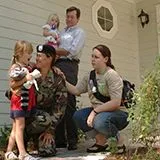On the Front Lines: Helping Military Spouses Thrive in Your Community

Credit: Daniel Bendjy on iStock
Series Description
This series on military family readiness aims to provide valuable resources, information, and support to family service professionals and Extension agents who support military families navigating the unique challenges and opportunities that come with a military lifestyle. From relocations to retirement, each publication in this series will equip you with the knowledge and resources you need to engage with service members and to promote readiness, resilience, and overall military family well-being.
Introduction
Military spouses play a vital role in military family readiness. Often facing unique service-connected challenges, military spouses are adaptable and resilient problem-solvers. One of the most significant challenges faced by military spouses is frequent relocation due to their partner’s deployments or duty station changes. These relocations can disrupt their careers, educational pursuits, and social networks, making it difficult to maintain stable employment and build lasting relationships. In addition to frequent moves, military spouses often shoulder responsibilities at home during their partner’s deployments. They become the primary caregiver for children and pets, handle household tasks, and manage the family’s finances while their partner is deployed. During service member deployments, military spouses are responsible for maintaining a sense of normalcy as they cope with the emotional strain of separation. Despite the circumstances, military spouses display remarkable adaptability as they learn to navigate new environments and support their families through the uncertainties of military life.
Knowing how to support military spouses in your service network can contribute to mission readiness, and help military spouses thrive in the communities you serve. This publication discusses:
- Military spouse demographics
- Military spouse employment
- Military spouse well-being including food security, financial security, and civilian community belonging
- Employment resources and strategies to support military spouses
Military Spouse Demographics
According to the Department of Defense (2023), the state of Florida has more than 140,406 personnel. This number includes active-duty members and dependents. Dependents are spouses, children, and adult dependents. There are 28,869 total spouses in the state of Florida, making it the fifth most-populated state for military spouses in the United States.
Military spouse demographics vary widely, reflecting the diversity of the armed forces community. Military spouses are predominantly female, with 91% of active-duty spouses and 86% of Reserve component military spouses identifying as women (Clearinghouse for Military Family Readiness, 2021). The average age of military spouses tends to be less than 36 years old, aligning with the age range of active-duty service members.
Military Spouse Employment
The Clearinghouse for Military Family Readiness (2021) highlights that 81% of military spouses have experienced a permanent change of station (PCS) within the last five years, with an average of 25.5 months since their last move. As a result of frequent relocations, military spouses may experience periods of unemployment or underemployment. According to the Bureau of Labor Statistics (2023), the national unemployment average for the general civilian population was 3.6% in July 2023. The Office of People Analytics (2023) identified 21% of civilian military spouses experiencing unemployment. Some reasons for increased rates of military spouse unemployment include:
- Caring for children not in school/daycare
- A PCS move in the last 12 months
The average civilian military spouse unemployment rate is higher for members of the Army (31%), racial/ethnic minorities (26%), and E-1 through E-4 (31%) (Office of People Analytics, 2023). According to the Office of People Analytics (2023), military spouses who live off-base and utilize child care have higher rates of employment.
Military Spouse Well-Being
Food Security
Military spouse unemployment may result in financial strain, career stagnation, and even food insecurity. According to the active-duty spouse survey, one in four active-duty spouses experiences low or very low food security (Office of People Analytics, 2023). According to the results from the survey of active-duty members (2021), experience of food insecurity increases by 17%–22% in military families where there is an unemployed spouse. Learn how to assess food security status through a short two-question screener described in this OneOp blog post.
Financial Security
The top PCS-related problems spouses face have financial implications (e.g., unemployment or underemployment, loss of income, non-reimbursable moving costs, housing costs, damaged or missing household goods). Despite high rates of unemployment, the Office of People Analytics (2023) found that military spouses have a higher financial well-being score (58) than the U.S. average (55), utilizing the Consumer Financial Well-Being Scale. Results from the 2022 Military Family Lifestyle Survey (2023) show similar findings of financial security among military families, including 72% of active-duty families reporting they are “doing okay” or “living comfortably” when asked to measure their family’s financial stress levels.
Belonging
Overall, 33% of active-duty families feel a sense of belonging to their local civilian community. Family service providers play an integral role in increasing that average by supporting military spouses in their community. According to the 2022 Military Family Lifestyle Survey (2023), active-duty spouses who used civilian resources reported feeling a greater sense of belonging to their civilian community. The most commonly used civilian resources include sports/recreation (for children and families), health care, and social support resources. Identifying and connecting with military spouses can bolster a robust support network and help military spouses have an increased sense of community belonging. Stress in military families can be high. Prioritizing self-care and the well-being of spouses and their families is critical.
Employment Resources for Military Spouses
Military spouses are highly skilled and qualified for a range of professions and careers. Frequent relocations and the unique challenges of military service mean that service providers may be uniquely positioned to provide employment resource coordination.
Consider providing the resources below to military spouses seeking employment in your community.
Inform military spouses about financial assistance programs available to support their education or training, such as the Military Spouse Career Advancement Account (MyCAA) program.
Suggest they create an account on the mySECO military spouse portal for professional career coaching, education and career pathways, resume building resources, and access to LinkedIn Premium.
- Connect military spouses with a career coach through the Department of Defense Spouse Education and Career Opportunities (SECO). Career coaches can provide specialized support for career transitions, working overseas, freelancing, and other industry-specific training. Call 800-342-9647 or visit Military OneSource to sign up.
- Foster networking opportunities for military spouses by encouraging them to participate in job fairs, become members of associations relevant to their field, and engage with fellow working military spouses. Experienced military spouses can offer valuable advice, exchange job hunting techniques, provide industry expertise, and contribute to the growth of their professional network.
Engage with the Military Spouse Employment Partnership (MSEP). Launched in June 2011, MSEP connects military spouses with employers committed to hiring them. MSEP offers job search resources for military spouses and virtual hiring events.
Encourage military spouses to explore job openings that offer flexible work arrangements, including teleworking or flexible scheduling. Also consider digital entrepreneurship options, including gig work, content creation, and influencer marketing. Remote work can provide greater flexibility when dealing with frequent relocations.
Encourage them to consider applying for the Military Spouse Career Accelerator Pilot program which provides a 12-week paid fellowship-to-employment pathway for military spouses with partner employers.
Encourage military spouses to contact their local Extension office to obtain information on upcoming classes pertaining to stress management and wellness, and/or resources and publications.
Service providers can gain a deeper understanding of the employment resources available to support the military spouses in their service networks with this on-demand webinar from OneOp. Expand your knowledge of the ways you can support the military families in your community by checking out other publications in the military family readiness series.
References
Blue Star Families. (2023). 2022 Military Family Lifestyle Survey: Comprehensive Report. https://bluestarfam.org/wp-content/uploads/2023/03/BSF_MFLS_Spring23_Full_Report_Digital.pdf
Clearinghouse for Military Family Readiness. (2021). The Military Spouse Experience: Current Issues and Gaps in Service. https://militaryfamilies.psu.edu/wp-content/uploads/2021/07/Military-Spouse-Experience_Current-Issues-and-Gaps-in-Service_3June2021.pdf
Department of Defense. (2023). Demographics Profile of the Military Community. Defense Manpower Data Center. https://download.militaryonesource.mil/12038/MOS/Reports/2022-demographics-report.pdf
Department of Defense. (2022). DoD Personnel, Workforce Reports and Publications. Defense Manpower Data Center. https://dwp.dmdc.osd.mil/dwp/app/dod-data-reports/workforce-reports
Office of People Analytics. (2023). 2021 Active Duty Spouse Survey (ADSS). https://download.militaryonesource.mil/12038/MOS/Presentations/2021-active-duty-spouse-overview-briefing.pdf
Office of People Analytics. (2021). Food Security of Active Duty Members. https://download.militaryonesource.mil/12038/MOS/Presentations/2020-status-of-forces-survey-active-duty-food-security-briefing.pdf





